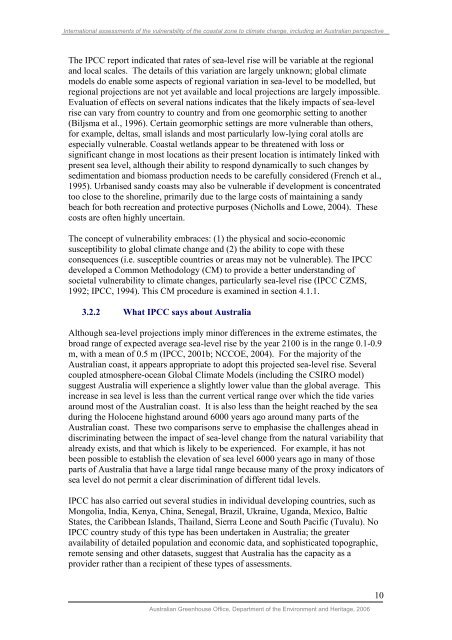International assessments of the vulnerability.pdf - Climate ...
International assessments of the vulnerability.pdf - Climate ...
International assessments of the vulnerability.pdf - Climate ...
You also want an ePaper? Increase the reach of your titles
YUMPU automatically turns print PDFs into web optimized ePapers that Google loves.
<strong>International</strong> <strong>assessments</strong> <strong>of</strong> <strong>the</strong> <strong>vulnerability</strong> <strong>of</strong> <strong>the</strong> coastal zone to climate change, including an Australian perspective<br />
The IPCC report indicated that rates <strong>of</strong> sea-level rise will be variable at <strong>the</strong> regional<br />
and local scales. The details <strong>of</strong> this variation are largely unknown; global climate<br />
models do enable some aspects <strong>of</strong> regional variation in sea-level to be modelled, but<br />
regional projections are not yet available and local projections are largely impossible.<br />
Evaluation <strong>of</strong> effects on several nations indicates that <strong>the</strong> likely impacts <strong>of</strong> sea-level<br />
rise can vary from country to country and from one geomorphic setting to ano<strong>the</strong>r<br />
(Biljsma et al., 1996). Certain geomorphic settings are more vulnerable than o<strong>the</strong>rs,<br />
for example, deltas, small islands and most particularly low-lying coral atolls are<br />
especially vulnerable. Coastal wetlands appear to be threatened with loss or<br />
significant change in most locations as <strong>the</strong>ir present location is intimately linked with<br />
present sea level, although <strong>the</strong>ir ability to respond dynamically to such changes by<br />
sedimentation and biomass production needs to be carefully considered (French et al.,<br />
1995). Urbanised sandy coasts may also be vulnerable if development is concentrated<br />
too close to <strong>the</strong> shoreline, primarily due to <strong>the</strong> large costs <strong>of</strong> maintaining a sandy<br />
beach for both recreation and protective purposes (Nicholls and Lowe, 2004). These<br />
costs are <strong>of</strong>ten highly uncertain.<br />
The concept <strong>of</strong> <strong>vulnerability</strong> embraces: (1) <strong>the</strong> physical and socio-economic<br />
susceptibility to global climate change and (2) <strong>the</strong> ability to cope with <strong>the</strong>se<br />
consequences (i.e. susceptible countries or areas may not be vulnerable). The IPCC<br />
developed a Common Methodology (CM) to provide a better understanding <strong>of</strong><br />
societal <strong>vulnerability</strong> to climate changes, particularly sea-level rise (IPCC CZMS,<br />
1992; IPCC, 1994). This CM procedure is examined in section 4.1.1.<br />
3.2.2 What IPCC says about Australia<br />
Although sea-level projections imply minor differences in <strong>the</strong> extreme estimates, <strong>the</strong><br />
broad range <strong>of</strong> expected average sea-level rise by <strong>the</strong> year 2100 is in <strong>the</strong> range 0.1-0.9<br />
m, with a mean <strong>of</strong> 0.5 m (IPCC, 2001b; NCCOE, 2004). For <strong>the</strong> majority <strong>of</strong> <strong>the</strong><br />
Australian coast, it appears appropriate to adopt this projected sea-level rise. Several<br />
coupled atmosphere-ocean Global <strong>Climate</strong> Models (including <strong>the</strong> CSIRO model)<br />
suggest Australia will experience a slightly lower value than <strong>the</strong> global average. This<br />
increase in sea level is less than <strong>the</strong> current vertical range over which <strong>the</strong> tide varies<br />
around most <strong>of</strong> <strong>the</strong> Australian coast. It is also less than <strong>the</strong> height reached by <strong>the</strong> sea<br />
during <strong>the</strong> Holocene highstand around 6000 years ago around many parts <strong>of</strong> <strong>the</strong><br />
Australian coast. These two comparisons serve to emphasise <strong>the</strong> challenges ahead in<br />
discriminating between <strong>the</strong> impact <strong>of</strong> sea-level change from <strong>the</strong> natural variability that<br />
already exists, and that which is likely to be experienced. For example, it has not<br />
been possible to establish <strong>the</strong> elevation <strong>of</strong> sea level 6000 years ago in many <strong>of</strong> those<br />
parts <strong>of</strong> Australia that have a large tidal range because many <strong>of</strong> <strong>the</strong> proxy indicators <strong>of</strong><br />
sea level do not permit a clear discrimination <strong>of</strong> different tidal levels.<br />
IPCC has also carried out several studies in individual developing countries, such as<br />
Mongolia, India, Kenya, China, Senegal, Brazil, Ukraine, Uganda, Mexico, Baltic<br />
States, <strong>the</strong> Caribbean Islands, Thailand, Sierra Leone and South Pacific (Tuvalu). No<br />
IPCC country study <strong>of</strong> this type has been undertaken in Australia; <strong>the</strong> greater<br />
availability <strong>of</strong> detailed population and economic data, and sophisticated topographic,<br />
remote sensing and o<strong>the</strong>r datasets, suggest that Australia has <strong>the</strong> capacity as a<br />
provider ra<strong>the</strong>r than a recipient <strong>of</strong> <strong>the</strong>se types <strong>of</strong> <strong>assessments</strong>.<br />
Australian Greenhouse Office, Department <strong>of</strong> <strong>the</strong> Environment and Heritage, 2006<br />
10

















